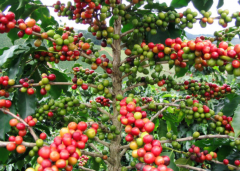Costa Rica Tara Sulamita Coffee with full grains and ideal acidity
Tarasu in Costa Rica is one of the major coffee producers in the world. The coffee is light and pure in flavor and pleasant in aroma. "Tarasu Latin America" coffee is a famous local product, but the production is limited, about 72600 kilograms a year. It is grown on a piece of land called "Latin America". In fact, this land can produce more than 450 tons of coffee a year. But Tarasu Latin America coffee is grown without artificial fertilizers or insecticides, and its harvesting and selection are done by hand, in order to avoid some damage to coffee beans caused by air spray selection. Other coffees worth mentioning are Juan Venus, Tulnon, Vidmir, Mondibelo and Santa Rosa. Fine coffee usually grows in Eredia and the central canyon. Another striking coffee is Saatchi, which grows on the slopes of Mount Boaz, 53 kilometers from San Jose. Saatchi, founded in 1949, has a land area of 30770 hectares and grows sugar cane and coffee. The area is also famous for its handicrafts, attracting tourists from all over the world.
Costa Rica's coffee industry, originally controlled by the Costa Rican Coffee Industry Corporation, has been taken over by the official Coffee Committee. Among the exported coffee, those products that are considered to be of substandard quality are colored with blue vegetable dyes and then transferred back to China for sale. Coffee consumed domestically (dyed blue or undyed) accounts for about 10% of total production, and local per capita coffee consumption is twice that of Italy or the United States.
Make a cup of Costa Rican coffee, pour it into the cup and taste it carefully, then you can appreciate its unique fragrance and rich flavor. The soft, moderate sour taste and rich aroma make the final rhyme reverberate in the throat for a long time, unforgettable. It has even been commented that some of the flavors of Costa Rican coffee are very similar to those of Kona and the Blue Mountains of Jamaica: full granules, ideal acidity and a unique strong flavor.
Costa Rica lies between the Pacific Ocean and the Atlantic Ocean, with Nicaragua in the south and Panama in the north. Flowers bloom and butterflies dance all the year round. Its coffee beans are famous for their mild taste, high acidity, aroma and rich texture, so they are favored by coffee tasters.
It is said that in 1779, the Spanish navigator Navarro brought coffee seeds from Cuba to Costa Rica, and Costa Rica began to grow coffee. High-quality Costa Rican coffee is called "extra hard beans". Costa Rica is a high-altitude country, and its coffee is grown above 1500 meters above sea level. The higher the altitude, the better the coffee beans, not only because the higher altitude can increase the acidity of the coffee beans and thus increase the flavor, but also because the night temperature at the higher altitude is lower, which can make the trees grow slowly, thus making the coffee beans have a stronger flavor. In addition, due to the high altitude drop caused by sufficient rainfall, is also very beneficial to the growth of coffee trees.
Today, its coffee industry is one of the most well-organized industries in the world, with a yield of 1700 kg per hectare. Costa Rica, with a population of only 3.5 million, has 400 million coffee trees, and coffee exports account for 25 per cent of the country's total exports. Costa Rica has the most complete government assistance system in the world coffee industry. in order to ensure the quality of coffee beans, the government has imposed strict restrictions on the output of coffee beans, producing only 80,000 tons per year. In the process of growing coffee in Costa Rica, try to avoid the use of chemical fertilizers and pesticides to maintain the most natural flavor. These factors make Costa Rican coffee beans famous in the international market and get the high grade of SHB+10 (selected highland coffee, high-quality coffee beans grown in areas above 1500 meters above sea level). In addition, Costa Rica's coffee industry has adopted new technologies to increase efficiency, including the use of "electric eyes" to select beans and identify coffee beans of irregular size.

Important Notice :
前街咖啡 FrontStreet Coffee has moved to new addredd:
FrontStreet Coffee Address: 315,Donghua East Road,GuangZhou
Tel:020 38364473
- Prev

Hope Manor Hacienda La Esperanza organic certification is the most famous is the rose summer seed
Hope Manor [country]: Panama [production area]: SHB [Variety]: Katula, Katuai, Iron pickup [baking]: CITY+ (moderate) [treatment]: washing [planting Environment]: altitude 1400-1600m [producer / Company]: hope Manor Hacienda La Esperanza [Certification]: organic certification [taste style]
- Next

Mantenin in Sumatra, Indonesia, with full grains and thick taste.
Manning coffee is grown at an altitude of 750 to 1500 meters above sea level and belongs to the rare Arabica coffee beans in Indonesia. The appearance of Mantenin coffee beans is arguably the ugliest, but coffee fans say that the worse the Sumatran coffee beans are, the better, mellow and slippery they are. Mantenin coffee beans have large granules and hard beans, and they are prone to defects in the process of planting.
Related
- Does Rose Summer choose Blue, Green or Red? Detailed explanation of Rose Summer Coffee plots and Classification in Panamanian Jade Manor
- What is the difference between the origin, producing area, processing plant, cooperative and manor of coffee beans?
- How fine does the espresso powder fit? how to grind the espresso?
- Sca coffee roasting degree color card coffee roasting degree 8 roasting color values what do you mean?
- The practice of lattes: how to make lattes at home
- Introduction to Indonesian Fine Coffee beans-- Java Coffee producing area of Indonesian Arabica Coffee
- How much will the flavor of light and medium roasted rose summer be expressed? What baking level is rose summer suitable for?
- Introduction to the characteristics of washing, sun-drying or wet-planing coffee commonly used in Mantenin, Indonesia
- Price characteristics of Arabica Coffee Bean Starbucks introduction to Manning Coffee Bean Taste producing area Variety Manor
- What is the authentic Yega flavor? What are the flavor characteristics of the really excellent Yejasuffi coffee beans?

